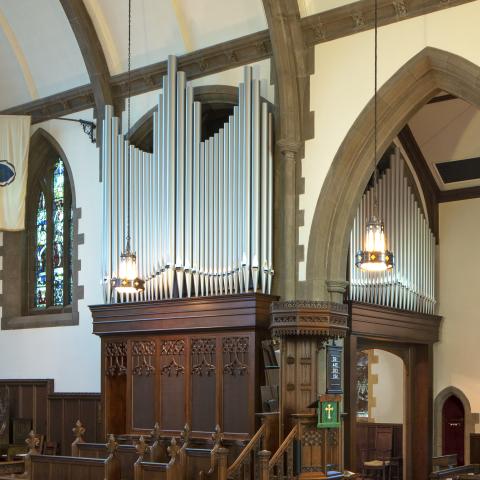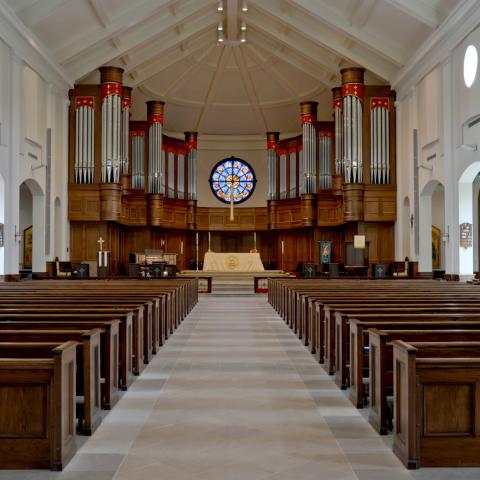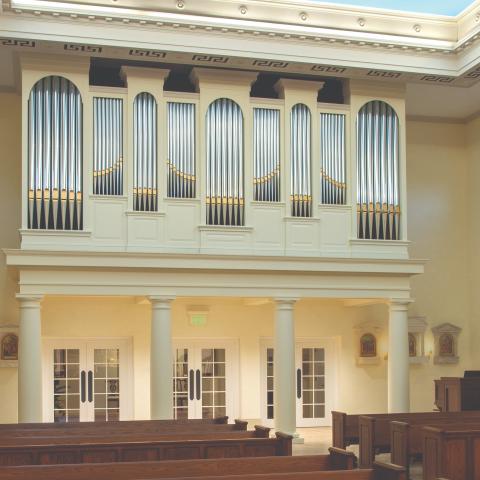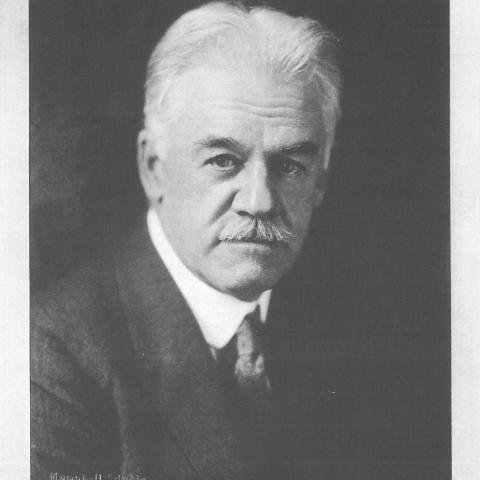Schoenstein & Co., Benicia, California
Saint John’s Episcopal Church, Tulsa, Oklahoma
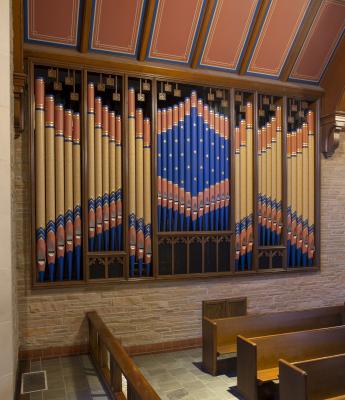
Schoenstein & Co., Benicia, California
Saint John’s Episcopal Church, Tulsa, Oklahoma
Selling the idea
A new pipe organ is, aside from the church building itself, often the most significant investment a congregation can make. When I knew I had the opportunity to see the commissioning of a new instrument for Saint John’s Episcopal Church, it was important for me that this project be a transformational experience for the parishioners. I wanted them to have an understanding of how a pipe organ works and become experienced enough listeners so that they would “know the difference” in the sound. I also believed a pipe organ project, when done right, could unite a parish community in a powerful way.
In the summer of 2015, I offered several organ demonstrations in which parishioners came to the console and had a glance into the organ chamber. They saw me “pull out all the stops,” open the swell shades, and I demonstrated different types of sound colors. In the ensuing months I would share with them some of the serious mechanical problems that made playing the 1966 M. P. Möller organ a constant challenge.
When the project took off, some lead donors and I first talked of rebuilding the existing organ. After fundraising was proving very successful, we believed a new instrument was the best use of funds. The Vestry ultimately approved a proposal from Schoenstein & Co. for a new instrument specifically designed to render music for a traditional Anglican service. Parish-wide enthusiasm culminated with a large crowd of more than 150 people on the day the new organ was delivered in July 2018. I will never forget people of all ages coming to help carry pipes and parts into the church. It was a very hot day, so the Schoenstein crew was relieved that with all the help, the truck was completely unloaded in just a few hours!
The new Schoenstein organ played for worship the first time on September 9, 2018, with a large congregation in attendance. It is no understatement to say that this instrument has completely changed the choral and congregational singing of the parish. Parishioners can clearly tell the difference, with descriptions of “pleasing sound,” “warmth,” and “clear bass.” As for me, I am falling in love with many anthems all over again. The possibilities for choral repertoire seem limitless, as my colleague Adam Pajan demonstrates every time he plays an accompaniment.
Beautiful, rich 8′ tone is essential for playing an Anglican service, and this new organ delivers. There are twelve separate 8′ foundation stops in the manuals. While each one has a distinct quality, they blend to form a sound that invites everyone to sing. Gone are the days when the 4′ Fugara, played down an octave, was the best “diapason!”
The new organ has much more solid bass that is powerful but never “tubby.” The 16′ Open Wood does much to support the congregation’s singing, and the soft 16′s, the Swell Bourdon and Choir Dulciana, still have clear fundamental tone. The upper work (2′ stops and mixtures) is restrained and adds brilliance to full ensembles.
There is so much variety in every tonal family, but I believe the biggest success is in the reed voicing. In the Swell, the 16′ Contra Fagotto has an 8′ extension that is a darker contrast to the brighter 8′ Cornopean. The Flügel Horn, sort of like a muted trumpet, makes a compelling addition to the 8′ foundations. This stop has been put to good use in “Hills of the North,” an anthem for women’s voices by Herbert Howells. Howells specifically calls for “darker” sounds in some places.
It is easy to forget that this new Schoenstein organ has merely thirty-eight ranks. The inner swell box, when closed, gives a restrained and darker sound to the Mixture, Cornopean, and Contra Fagotto. It also means that a huge crescendo can be achieved by simply opening both sets of swell shades. A comparable effect on other instruments would usually require adding a sequence of many other stops.
In the end, it is no surprise to me that parishioners love both the sound and façade of the new organ. A most welcome surprise was the way in which this project rallied us all together. May this new organ offer praise to God and lift the hearts of worshippers for many generations to come.
—Joseph Arndt, Music Director
Saint John’s Episcopal Church
The organ’s inner beauty
When most people think about an organ, the first thing that comes to mind is the console or the organ case with display pipes. This would certainly be true of our latest organ at Saint John’s Episcopal Church in Tulsa, Oklahoma. With a handsome console and vibrantly stenciled display pipes, these visual portions certainly stand out. The casework and its display pipes offer an opportunity to utilize elements inspired by the room’s architecture to create a memorable and cohesive design. If done well, this often results in the phrase, “it looks like it’s always been there,” a compliment the builder always appreciates.
Many also believe the visible display pipes encompass the entire sound-producing portion of the organ. There is no compelling reason for them to think that forty display pipes would not suffice to produce all the beautiful tones they hear each Sunday at worship. And since organ chambers are usually off limits (for good reason), any secrets held within are kept safely guarded. After all, the display pipes are meant to conceal what is behind.
But what happens inside the organ? Although not thought of as beautiful in the traditional sense, the interior of the pipe organ is attractive in many ways. The supporting framework or chassis, the expression shades, wind lines, regulators and electrical cables all create a different kind of beauty—that of organized engineering. The care that goes into this process, starting with the design on the drawing board and following through to the end of the installation, is attended to by skilled craftsmen and artists whose work may never be seen or appreciated except by the very few.
The chassis—made up of wooden legs, bearers, and other supporting structure—are all made from the highest quality materials and finished as if they were to be viewed by the public. Tubing that conveys the wind to the display pipes is arranged not only along the most efficient path but is bundled neatly and secured, imitating exhaust tubes of a classic Duesenberg SJ. The cabling that transmits the desires of the organist to the appropriate pipes can be found meandering its way throughout the instrument in the neatest manner.
Why are all these things done with such care and pride, when no one except the organ technician will see them? The main reason is an organ that exhibits careful design and thoughtfulness for the placement of each component demonstrates the commitment and pride of the builder and wins the respect of organ technicians. An organ whose workings are accessible for easy service will be maintained well over the years because it is a joy to work on. The occasional issue that arises will be easy to resolve due to the wisely considered layout of the systems. Accessible components allow everything to be maintained at the highest level.
How does the congregation come to appreciate this unseen portion of the organ? One way is to start with the unloading of the organ on delivery day. The response will vary by church, but at Saint John’s the one-hundred-fifty-some members who assisted in that task certainly have a good idea of what makes up the total pipe organ. Helping to carry in the thousands of organ pipes and parts, they gained a hands-on knowledge. Throughout the installation, members would stop by to observe the progress and ask questions. Any naysayers to the acquisition of a new organ are often converted to strong supporters during this interval.
Another way to involve the church members is through education sessions during the installation. Music Director Joseph Arndt offered these directly after worship during the installation period to demonstrate certain aspects of the organ before the case and display pipes were put in place. Easily observed at this point is the working of the inner and outer expression shades of the Swell. A visual demonstration of an aural effect is a tremendous teaching device. Interested members also posted short videos to Facebook and other social media. The reaction to such postings continues to generate interest.
The local news media is another venue that should not be overlooked. Two crews from local news channels visited the church during the installation, first for unloading day and then later in the process when the first pipes started to play. A local viewer saw the installation on the news broadcast and came by the church for a personal visit. It turns out she was a friend of a Schoenstein family member she had been out of touch with for many years. Because we still have close ties with the Schoenstein family, we were able assist her in reuniting with her friend.
While the external portions of the pipe organ are often a work of art, there is just as much, if not more, to see behind the façade. The expert skills of the artisans who built the instrument are on full display and remain a testament to those who bring their talent to the task. As with other endeavors built for the ages, future generations will appreciate the “inner beauty” of their pipe organ.
—Louis Patterson,
Vice President and Plant Superintendent
Schoenstein & Co.
Collaboration
I had the privilege of meeting Joseph Arndt and becoming involved in the music ministry at Saint John’s Episcopal Church once the contract for the new instrument had already been signed. While some details of the specification were still open for discussion, the overall concept for the organ was clear: it needed to be a servant to the liturgy and the music that adorns it.
In the following months, Joseph and I spent many hours in discussion about which components really needed to be in place and which ones, while beneficial and meritorious in their own right, might acquiesce to those that could potentially better fulfill the vision. Our conversation continued to evolve following a visit to a recent Schoenstein organ, which helped inform what would become the final specification.
The Choir division saw the most dramatic transformation toward a division with diverse 8′ color, intended primarily for accompanying and solo effects. Mutations moved to the Great, where they now play a role as members of the principal chorus. Double expression in the Swell division allows it to function like an additional manual. The amount of color and power that can be controlled to a dynamic level appropriate for choral accompaniment makes the Schoenstein an overwhelming success. Each voice is individually beautiful, making the collective all the more so. It is an honor to support Joseph as Artist in Residence and to have acted as a kind of advisor and friend in the planning process. Making music at Saint John’s is more fulfilling than ever, and the future is bright indeed.
—Adam Pajan, Artist in Residence
Saint John’s Episcopal Church
GREAT (Manual II)
16′ Double Diapason 61 pipes
8′ First Open Diapason 61 pipes
8′ Second Diapason (ext 16′) 12 pipes
8′ Harmonic Flute 61 pipes
8′ Bourdon 61 pipes
4′ Principal 61 pipes
4′ Silver Flute 61 pipes
22⁄3′ Twelfth (TC) 42 pipes
2′ Fifteenth 61 pipes
13⁄5′ Seventeenth (TC) 42 pipes
11⁄3′ Mixture III–IV 187 pipes
8′ Trumpet 61 pipes
SWELL (Manual III, expressive)
16′ Lieblich Bourdon (ext 8′) 12 pipes
8′ Horn Diapason 61 pipes
8′ Stopped Diapason 61 pipes
8′ Gamba † 61 pipes
8′ Gamba Celeste † 61 pipes
4′ Gemshorn 61 pipes
4′ Harmonic Flute 61 pipes
2′ Flageolet 61 pipes
2′ Mixture III–V † 236 pipes
16′ Contra Fagotto † 61 pipes
8′ Cornopean † 61 pipes
8′ Fagotto (ext 16′) † 12 pipes
8′ Oboe Horn 61 pipes
Tremulant
† Stops under double expression
CHOIR (Manual I, expressive)
16′ Double Dulciana (ext 8′) 12 pipes
8′ Dulciana 61 pipes
8′ Unda-Maris (TC) 49 pipes
8′ Concert Flute 61 pipes
8′ Lieblich Gedeckt 49 pipes (Concert Flute Bass)
4′ Concert Flute (ext 8′) 12 pipes
4′ Lieblich Gedeckt (ext 8′) 12 pipes
22⁄3′ Nazard (fr Lieb Ged)
16′ Ophicleide (ext 8′) 12 pipes
8′ Tuba 61 pipes
8′ Flügel Horn 61 pipes
8′ Corno di Bassetto 61 pipes
Tremulant
PEDAL
32′ Resultant
16′ Open Wood 32 pipes
16′ Double Diapason (Gt)
16′ Double Dulciana (Ch)
16′ Lieblich Bourdon (Sw)
8′ Principal 32 pipes
8′ Horn Diapason (Sw)
8′ Dulciana (Ch)
8′ Flute (Gt Harmonic)
8′ Stopped Diapason (Sw)
4′ Fifteenth (ext 8′) 12 pipes
4′ Flute (Gt Harmonic)
2′ Twentysecond (ext 8′) 12 pipes
16′ Ophicleide (Ch)
16′ Contra Fagotto (Sw)
8′ Tuba (Ch)
8′ Fagotto (Sw)
4′ Corno di Bassetto (Ch)
Normal couplers and accessories
Three manuals, 31 voices, 38 ranks
Electric-pneumatic action
Great 771 pipes
Swell 870 pipes
Choir 451 pipes
Pedal 88 pipes
Total 2,180 pipes
TONAL ANALYSIS
PITCH SUMMARY
16′ and below 5 16%
8′ 16 52%
4′ 4 13%
Above 4′ 6 19%
31 100%
TONAL FAMILIES
Diapasons 14 45%
Open Flutes 5 16%
Stopped Flutes 3 10%
Strings 2 6%
Chorus Reeds 4 13%
Color Reeds 3 10%
31 100%
Photo credit: Louis Patterson
Builder’s website: www.schoenstein.com
Church website: www.sjtulsa.org

